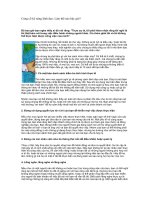Tài liệu Hội thảo kỹ năng quản lí doc
Bạn đang xem bản rút gọn của tài liệu. Xem và tải ngay bản đầy đủ của tài liệu tại đây (1.13 MB, 276 trang )
Hội Thảo Kỹ Năng Quản Lý
Workshop on Management and Leadership
Bui X. Tung
Shidler College of Business
University of Hawaii, USA
TTHL Can Tho, 10-2007
Outline
(Nội dung)
Leadership and Influence
Decision making and problem solving
Change Management
Human Resource Management
Empowerment and persuasion
Planning, time management, delegation
Recruitment, retention and personnel development
Negotiation
Disclaimer
(Những nội dung không đề cập)
Western perspective
Private perspective
Is it the right time, right location, right people?
Credits
(Đội ngũ tham gia soạn thảo)
Elaine Bailey, University
Kem Lowry, Uni of Hawaii
Deb Fennell, Dart Energy
Thomas Little, Inc.
Part I
Leadership and Influence
(Kỹ Năng Quản Lý
& Ảnh hưởng)
Our Agenda
(Nội dung)
Learning to understand the effect of paradigms on persons,
organizations and cultures and how they frame the conceptions
of leadership.
Distinguishing between “Transactional” and
“Transformational” leadership paradigms
Demonstrating the effect of paradigms and style on one’s
conception of leader effectiveness and organizational
effectiveness.
Leadership as a Democratic Ideal
(Kỹ năng quản lý theo quan niệm dân chủ)
American foundations are discovered in the
concept of a free and responsible citizenry
participating in accountable ways to
advance the individual and common well
being
How can we build a free, responsible
citizenry?
Transformational Leadership
(Kỹ năng quản lý chuyển hoá)
Transformational Leadership emerged with its
emphasis on change and forward movement and the
development of followers as full human beings.
Three Approaches.
1. Burns, Kotter, and Kouzes and Posner, propose the leader is
to develop a vision and to align constituents and followers
around that vision through the use of persuasive
communication, inspiration, and empowerment.
2. Heifetz and Laurie, Lipman-Blumen, sees leader’s role as
tapping into the collective wisdom of the group to co-create
a shared vision, create connections between personal
aspirations and work, and provide workers with the
resources, encouragement, and support needed to achieve
goals.
Principled Centered / Servant Leadership
( Lãnh đạo theo nguyên tắc trung/ Lãnh đạo theo Tinh thần
phục vụ )
A third school of contemporary leadership
Covey’s theory of Principle-Centered Leadership
Greenleaf’s concept of Servant Leadership.
Return to leadership’s historic roots as an ethical discipline.
Growing recognition that modernization does not automatically
lead to human progress in the form of greater freedom, justice and
equality.
Greenleaf proposes true leaders are first attracted to a moral cause
and become leaders in service to that cause. Their responsibility
as leaders is to serve the needs of their followers.
The “Learning” Leader
(Người quản lý luôn học hỏi, tiếp thu)
1990s, Peter Senge, in the Learning Organization
proposes:
organizations must engage in continuous learning to keep pace
with global change
learning disabilities prevent most organizations from
accomplishing effective learning and leadership
proposed methods for overcoming these disabilities include
see organizational patterns and relationships,
question the deeply held assumptions that underlie organizational
practice,
seek systemic solutions to problems, rather than blame targets
Emerging Leadership and Global Awareness
(Kỹ năng quản lý & Nhận thức chung)
Requires leaders to confront the issues of freedom, equality
and justice on a massive scale in pluralistic and diverse
nations and organizations
Diffuse technology and the growth of global corporations can
promote human well-being or create new levels of disparity
that contribute to poverty, poor health, and global conflict.
Ethical choices that leaders make have repercussions for eras
to come.
Reemergence of the “responsible individual” with values and
communicative relationships
New Leadership Options
(Những kỹ năng quản lý mới)
Leadership must emphasize talent and environment by:
Creating a learning environment
Reducing fear that interferes with collaboration and
communication
Diversified where people value difference as competitive
advantage
See problems as opportunities
Leverages the organization mission and manages talent
Your Paradigmatic Options
(Lựa chọn cho bản thân một kiểu quản lý)
What are your assumptions about leadership and its
competitive strategic advantage?
What are the opportunities your assumptions bring to the
leadership and the organizational situation?
How will you be able to solve problems more
effectively better using your paradigm?
But be careful… Your Paradigm is not always Others’ paradigm
When YOUR Paradigm Is Not THEIR
Paradigm
(Khi kiểu quản lý của bạn không phù hợp với những người
khác)
There Are Three Kinds Of People in
Leadership
(Có 3 mẫu người lãnh đạo)
Those who MAKE things happen
Those who WATCH things happen
Those who WONDER what happened
COLLINS'S LEVELS OF
LEADERSHIP
Sơ đồ Các cấp độ quản lý của Collin
.
LEVEL 1
HIGHLY
CAPABLE
INDIVIDUAL
Makes productive
contributions
through talent,
knowledge, skills
and good work
habits.
LEVEL 5
EXECUTIVE
Builds enduring value &
greatness through a
blend of personal
humility and
professional will.
LEVEL 4
EFFECTIVE
LEADER
Catalyzes commitment
to and vigorous pursuit
of a clear and
compelling vision,
stimulating higher
performance standards
LEVEL 3
COMPETENT
MANAGER
Organizes
people/resources
toward effective
and efficient
pursuit of
predetermined
goals.
LEVEL 2 CONTRIBUTING
TEAM MEMBER
Contributes personal
capabilities to achievement of
group objectives and works
effectively with others in a
group setting.
Matching Style and Group Maturity
T
A
S
K
RELATIONSHIP
H
L
H
L
TELL
COACH
Work Task
Resource Use
Assess & Learn
ADVISE
SHOW
1
234
What do we need to improve as
leaders?
(Với vai trò là một người lãnh đạo cần cải thiện những
gì?)
“Leaders bring people together to
make things happen …
and do ”
What Do
Leaders Do?
(Người lãnh đạo Làm gì?)
Your Hero’s
LEADERSHIP PRACTICES
1. ________________________
2. ________________________
3. ________________________
4. ________________________
5. ________________________
6. ________________________
Your
Hero?
Building Effective Business
Relationships
(Tạo dựng các mối quan hệ thuận lợi cho công việc)
Credibility
(+)
Consistency
(+)
Communication
=
Leadership
Success
HOW DO YOU MAKE A DIFFERENCE…
(Làm thế nào để tạo ra sự thay đổi…)
I Now…
A Leadership Formula
(Công thức Quản lý)
B = C + E + A
B = C + E + A
A Leadership Formula
(Công thức Quản lý)
B = C + E + A
Behavior
Context
Energy
Attitude
The Leadership Goal
(Mục tiêu quản lý)
“The ultimate test of leadership is
its ability to create in the business
system the drive and commitment
to achieve real, tangible value for
all of the business’ customers
through all of the business’
processes, services and products
and the people who operate them. ”









